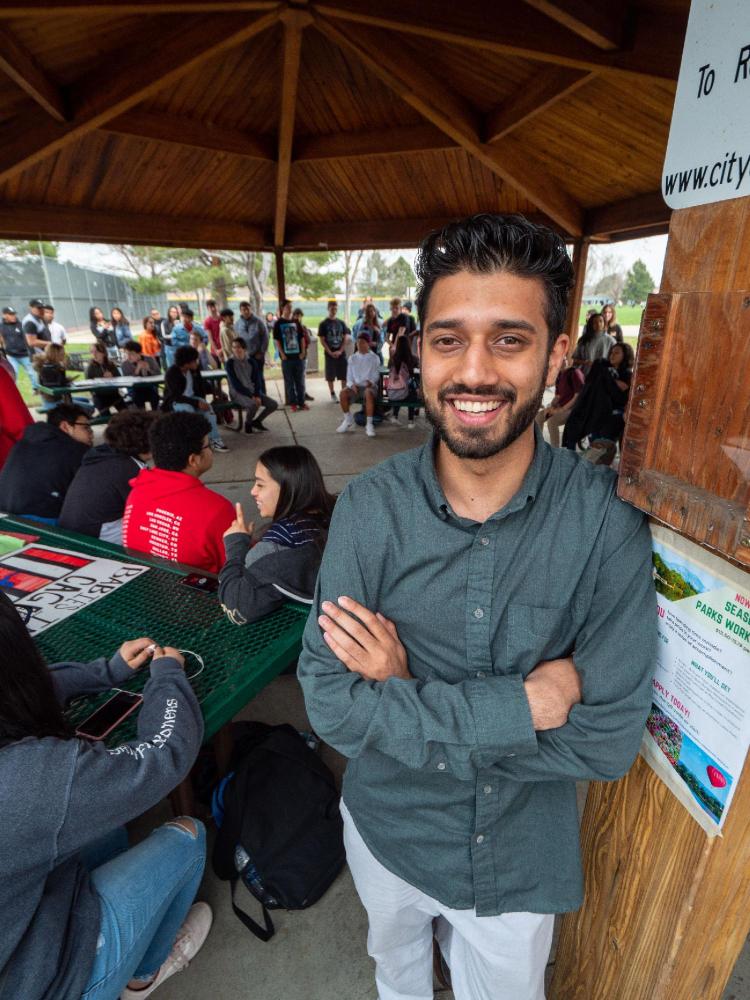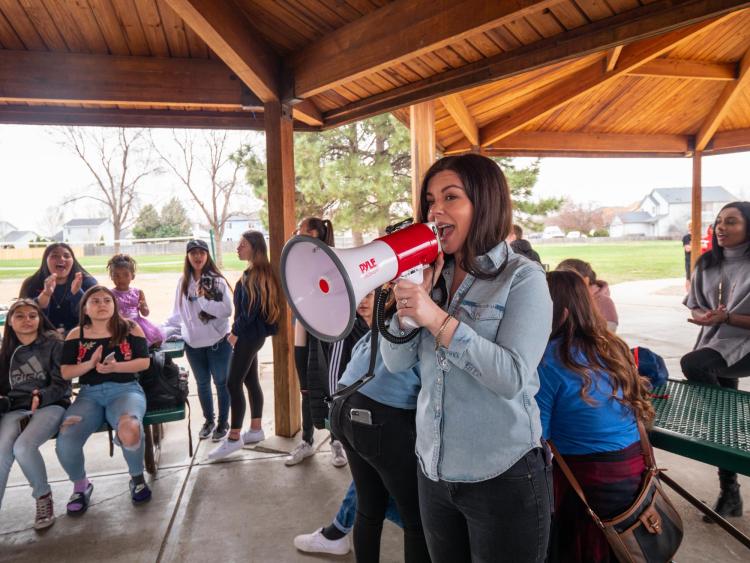Youth Rising
How today's youth are finding their voice, and what we can learn from them
“Say it loud, say it clear, immigrants are welcome here,” the high school students chanted as they carried colorful signs and blasted messages via megaphone. Drivers slowed and many honked as the marchers made their way down a busy thoroughfare in Lafayette, a diverse city in east Boulder County.
The students organized the march and school walkout to raise awareness and support for immigrant families in their community. About 150 students across all gradelevels attended, but the affair was arranged by just six ninth-graders with support from three CU Boulder student coaches in the Public Achievement program. The initiative promotes youth voice and transformative change with coaches working alongside K–12 students to design civic action projects.
Across the nation, youth movements and moments like these are capturing headlines, and youth activism, while not new, appears to be on the rise.
Youth leaders and advocates
In Lafayette, the students organizing the walkout ensured it was an offsite, unofficial school function and coordinated with police and city officials, who not only supported and protected the marchers but spoke at the culminating rally in a local park.

The mayor honored the students as did JD Mangat, a familiar face to many at the rally. Mangat is a former Public Achievement middle and high school participant and CU Boulder student coach. The alumnus is now the youngest member on the Lafayette City Council at age 23.
The councilor has had a lengthy record of public service to his hometown, beginning with his Public Achievement group’s project raising awareness about gun violence and his work as a youth advisory board member pushing back on youth curfews and restrictions on loitering, and establishing the city’s acclaimed skate park.
“Whether it’s here or L.A., young people face a lot of issues—boredom, or they’re not trusted enough,” said Mangat, who, despite not being a skateboarder himself, saw the skate park as an opportunity to support peers. “(As a leader) you learn to prioritize the needs of the community.”
The son of Indian immigrants, Mangat said his philosophy throughout his work as a youth leader and as a city official has remained unchanged: All people deserve to be heard and to be treated equally with respect. Charla Agnoletti, Public Achievement’s director and a former college coach, says that theme is embraced by the program, which is a part of the School of Education’s CU Engage: Center for Community-based Learning and Research.
When young people are really given the space to express their voice, there’s a lot of magic there,” she said. “I believe living within young people are the solutions, innovations and the radical imagination needed to continue to make our schools and our society a better place.”
Youth-led movements, big and small
The past couple of years have featured highly publicized surges in youth activism, from local to large-scale movements. Local actions can be inspired by national movements, and recent activism is often built on the social movements that came before. The latest movements and their predecessors have been borne out of injustice and racism, and researchers like Ben Kirshner study what motivates activism and how young activists learn in these settings.
“Some contemporary forms of activism have a local focus, or they may stem from an inciting event, like the March for Our Lives,” said Kirshner, professor of learning sciences and human development, and faculty director for CU Engage. “The question is: How do you sustain something after an initial spark, and how do you build something local that has a bigger base that links cities and regions? We can learn more about both of those processes from social movements of the past.”
Learning from the past and present
African American youth were pivotal in the civil rights movement, leading lunch counter sit-ins in North Carolina and the Freedom Summer efforts to register African American voters. There is also a proud tradition of school walkouts to protest poor conditions and segregation, such as what occurred with the Chicano movement, where students famously led walkouts or “blowouts” in places like Los Angeles and Denver to bring awareness about racism in schools and call for culturally responsive policies and practices.
In more recent years, Kirshner points to the Dreamer movement, with its leadership from undocumented youth of all ages, and the activism affirming gender and sexual diversity, as movements that have been driven, in large part, by youth.
In his early career as a youth worker in San Francisco’s Mission District, Kirshner found himself interested in understanding what kind of learning environments support youth to step into these activist roles. In the 1990s, activism led by youth of color in San Francisco and Oakland focused on challenging systems and policies to fight against new “super jails” for teenagers and to gain support for educational programs and summer jobs for youth. Kirshner found inspiration in those movements, which led to his work today teaching in education and exploring learning environments that advance educational equity.
Youth movements and schooling
Historically, the education system has played a complicated role in youth activism. High schools have not traditionally cultivated youth voice and leadership, particularly for youth of color. Often the opportunities for student leadership that do exist are limited to planning proms or organizing fundraisers. Yet schools can be a place where students meet, coordinate and, at times, make change.
Kirshner has been studying out-of-school and in-school programs that provide youth opportunities to substantively name injustices they have experienced, carry out researchand develop policies to address issues at the root level.
“I really believe in the potential of schools to be spaces of youth development and voice, and that shouldn’t be something that is just nurtured outside of school,” Kishner said.
Blanca Elena Trejo, a master’s graduate and current PhD student who works with Kirshner in CU Engage, was a high school sophomore in Denver when she first became involved in youth organizing, but she admits she started out a skeptic.
“I will be honest, just as I am with students. I did not get involved with youth organizing work because I wanted to change the world or because I authentically believed that youth can make a difference,” she said. “When the student body president came into my chemistry class to recruit for a new club that would ‘change West High School,’ I remember rolling my eyes and leaning further back in my chair.”
Lured by free pizza, Trejo showed up for that first meeting anyway, and she has been showing up for youth organizing ever since.
Skepticism turned to activism

"I believe living within young people are the solutions, innovations and the radical imagination needed to continue to make our schools and our society a better place."
Trejo found the group’s coordinator to be a caring Latina who “authentically made me and my peers feel like we were powerful beings who could effect positive change in our school and community.” As a young Latina, Trejo knew of the teen pregnancy and school dropout statistics, and she had seen her family ripped apart by the immigration system and racial bias. Her committee work became a refuge, and the self named Voices Heard Committee played a key role in helping establish Colorado’s in-state tuition for undocumented youth legislation, known as Colorado ASSET.
Trejo was recruited and trained as a youth leader for several other local and national organizations while in high school, and she dreamed of starting her own nonprofit as she navigated the challenges of attending a predominantly white, upper-class university as a first-generation undergraduate student.
“I am blessed to have been trained to self-advocate through youth organizing work,” she said.
After graduating—with three degrees—Trejo co-founded INSPiRE, a Colorado nonprofit that combines college and career readiness curricula with youth organizing to support youth in becoming change agents in their schools, families and communities.
Finding inspiration
Kirshner has seen how building coalitions can build strength between parents and youth of different ages and backgrounds, community members and other civic groups. He admits that even after years of working with youth leaders and studying youth activism, at times he can fall into a trap of assumptions and stereotypes about youth that are promulgated in the academy and media. He finds working directly with youth organizers and witnessing their courage and creativity provides the best “proof point for what youth are capable of, in contrast to what a lot of our systems tell us they can do.”
Back at the walkout in Lafayette, Agnoletti is in awe of what the youth can do, and she knows they are proud, too. She enjoys seeing the young organizers go from self-doubting to finding their confidence and agency as citizens and leaders in their communities.
Agnoletti believes it is time to stop doubting and start listening to youth. She points out that the walkout that was planned and executed by high schoolers was inspired by another group of Public Achievement students, middle schoolers who led a similar initiative and left a blueprint for others.
“In this case, a team of ninth-graders were inspired by the work of seventh-graders,” she said. “We can always learn from people who are younger than us, and in young people is where hope and inspiration has always resided.”
Learn more about Public Achievement at colorado.edu/publicachievement and CU Engage at colorado.edu/cuengage.
Story illustration by Maria Carluccio c/o theispot

